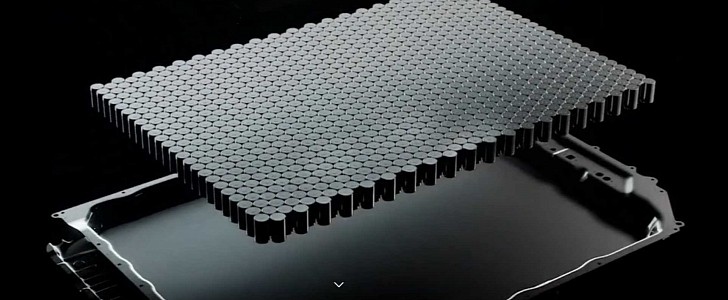Tesla has an ambitious plan to put 20 million electric vehicles on the roads by 2030, and the new 4680 cells are key to this plan. Thanks to the bigger cells and innovative manufacturing process, Tesla could halve the costs of the Model Y battery, but there’s a problem.
Tesla introduced the 4680 cells in 2020 as a critical piece of the puzzle to achieve price parity with ICE vehicles. They were also part of the new structural battery packs in the Tesla Model Y, although not a requirement. Tesla already uses both 4680 and 2170 cells in structural battery packs at Giga Berlin. Nevertheless, the 4680 cells can potentially cut the costs of batteries in half.
To achieve this, Tesla employs a new production technique called dry-coating. The technology allows to push down costs significantly, but even Musk had to concede it would be challenging to execute. Tesla acquired the know-how in 2019 when it bought Maxwell Technologies, a San Diego company making ultracapacitors.
Typically, battery electrodes are coated using a wet process, mixing the materials with toxic binder solvents. Once coated, the electrodes need to be dried in massive ovens, and the poisonous solvents that evaporate in the process need to be recovered, treated, and recycled. All this adds significant costs, labor, and factory space. With the dry-coating process, electrodes are coated using different binders with little use of liquids, so they don’t need to be dried.
This is way cheaper, faster, and better for the environment. The energy consumption is one-tenth of the wet coating process, while capital spending is cut by a third. You see why this process is crucial to lowering the costs of Li-Ion batteries. But to do this, the process needs to scale to the point where the big cost savings kick in, as one battery expert told Reuters.
There lies the problem because, apparently, the process is not yet ready for prime time. In fact, we could guess that already by the fact that Musk promised mass production “by the end of 2022.” Some experts consulted by Reuters, some connected to Tesla, think the process might not be ready even by 2023. The technology is promising, but Maxwell developed it for use in ultracapacitors, not batteries.
The challenge with dry coating electrodes for EV batteries is that they are much larger and thicker than in the case of ultracapacitors. This makes it hard to keep a consistent quality at mass-production speeds. According to Reuters, the production yields were so low that all the anticipated cost savings from the new process were lost.
But once the production problems get sorted out, the potential savings from using the technology can go as high as $5,500 per battery pack. This means cutting the costs in half compared to a 2170 battery pack. Considering the batteries are the most expensive single component of an electric vehicle, this could save 8% of a Tesla car’s price, the experts admit.
To achieve this, Tesla employs a new production technique called dry-coating. The technology allows to push down costs significantly, but even Musk had to concede it would be challenging to execute. Tesla acquired the know-how in 2019 when it bought Maxwell Technologies, a San Diego company making ultracapacitors.
Typically, battery electrodes are coated using a wet process, mixing the materials with toxic binder solvents. Once coated, the electrodes need to be dried in massive ovens, and the poisonous solvents that evaporate in the process need to be recovered, treated, and recycled. All this adds significant costs, labor, and factory space. With the dry-coating process, electrodes are coated using different binders with little use of liquids, so they don’t need to be dried.
This is way cheaper, faster, and better for the environment. The energy consumption is one-tenth of the wet coating process, while capital spending is cut by a third. You see why this process is crucial to lowering the costs of Li-Ion batteries. But to do this, the process needs to scale to the point where the big cost savings kick in, as one battery expert told Reuters.
There lies the problem because, apparently, the process is not yet ready for prime time. In fact, we could guess that already by the fact that Musk promised mass production “by the end of 2022.” Some experts consulted by Reuters, some connected to Tesla, think the process might not be ready even by 2023. The technology is promising, but Maxwell developed it for use in ultracapacitors, not batteries.
The challenge with dry coating electrodes for EV batteries is that they are much larger and thicker than in the case of ultracapacitors. This makes it hard to keep a consistent quality at mass-production speeds. According to Reuters, the production yields were so low that all the anticipated cost savings from the new process were lost.
But once the production problems get sorted out, the potential savings from using the technology can go as high as $5,500 per battery pack. This means cutting the costs in half compared to a 2170 battery pack. Considering the batteries are the most expensive single component of an electric vehicle, this could save 8% of a Tesla car’s price, the experts admit.







